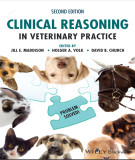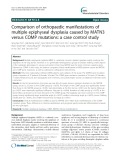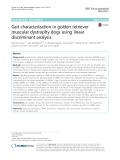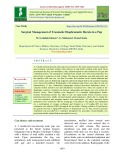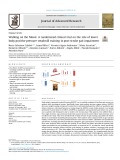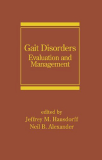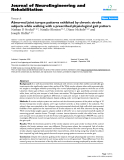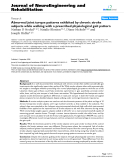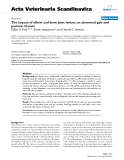
Gait abnormality
-
Part 2 book "Clinical reasoning in veterinary practice - Problem solved" includes content: Bleeding; polyuria polydipsia and urinary incontinence; gait abnormalities; pruritus, scaling and otitis; problem based approach to problems of the eye; problem based approach to small mammals – rabbits, rodents and ferrets; problem based clinical reasoning examples for equine practice; principles of professional reasoning and decision making.
 221p
221p  muasambanhan10
muasambanhan10
 03-04-2024
03-04-2024
 4
4
 0
0
 Download
Download
-
Ebook Symptom - Based diagnosis in pediatrics (2nd edition): Part 2 includes content: Altered mental status, rash, pallor, fever, fever, neck swelling, chest pain, jaundice, abnormal gait, including refusal to walk, diarrhea, syncope, seizures.
 525p
525p  oursky04
oursky04
 05-09-2023
05-09-2023
 8
8
 2
2
 Download
Download
-
Multiple epiphyseal dysplasia (MED) is a relatively common skeletal dysplasia mainly involving the epiphyses of the long bones. However, it is a genetically heterogeneous group of diseases sharing certain aspects of the radiologic phenotype.
 8p
8p  viannito2711
viannito2711
 20-04-2021
20-04-2021
 11
11
 2
2
 Download
Download
-
Gait characterization in golden retriever muscular dystrophy dogs using linear discriminant analysis
Accelerometric analysis of gait abnormalities in golden retriever muscular dystrophy (GRMD) dogs is of limited sensitivity, and produces highly complex data. The use of discriminant analysis may enable simpler and more sensitive evaluation of treatment benefits in this important preclinical model.
 9p
9p  vitennessee2711
vitennessee2711
 02-02-2021
02-02-2021
 5
5
 1
1
 Download
Download
-
A one-month-old, 30 kg calf was presented to Referral Veterinary Polyclinic ICAR-IVRI, Bareilly, with the history of anorexia, salivation, dullness, ataxia, laboured breathing and administration of bolus having a combination of fenbendazole (3000mg) and ivermectin (100mg). Clinical examination revealed pale mucous membrane, mydriasis, the absence of pupillary and menace reflex, sticky salivation, normal body temperature, tachycardia, tachypnoea, dull, depressed, sudden fall with tremors, abnormal posture and gait.
 6p
6p  nguathienthan4
nguathienthan4
 18-04-2020
18-04-2020
 9
9
 1
1
 Download
Download
-
A 3 month-old non-descript male pup was presented to the small animal surgery outpatient unit at madras veterinary college with a history of road traffic accident a day back. Upon presentation the dog was ambulatory, dull, and nonresponsive and exhibited a stiff gait and a hunched posture. On auscultation, muffled heart sounds were observed and dysnea was noticed due to reduction of tidal volume. The mucous membrane was pink and moist and the capillary refill time was less than 2 seconds.
 4p
4p  caygaocaolon4
caygaocaolon4
 04-04-2020
04-04-2020
 13
13
 3
3
 Download
Download
-
Body weight–supported treadmill training (BWSTT) can be usefully employed to facilitate gait recovery in patients with neurological injuries. Specifically, lower body positive pressure support system (LBPPSS) decreases weight-bearing and ground reaction forces with potentially positive effects on qualitative gait indices. However, which gait features are being shaped by LBPPSS in post-stroke patients is yet poorly predictable. A pilot study on the effects of LBPPSS on qualitative and quantitative gait indices was carried out in patients with hemiparesis due to stroke in the chronic phase.
 10p
10p  trinhthamhodang1
trinhthamhodang1
 14-11-2019
14-11-2019
 11
11
 1
1
 Download
Download
-
The ability to walk safely, easily, and in an aesthetically pleasing manner is a skill learned early and highly prized. Although it is typically taken for granted, gait is key to mobility and functional independence and at the core of our ability to carry out many activities of daily living. In older adults and patients with neurological deficits, ease and safety in walking may become compromised, and gait is often viewed as abnormal, i.e., as a disorder. While not an inevitable part of aging, gait disorders are common among older adults and in patients with neurological disease.
 436p
436p  crius75
crius75
 04-01-2013
04-01-2013
 38
38
 3
3
 Download
Download
-
Tuyển tập báo cáo các nghiên cứu khoa học quốc tế ngành hóa học dành cho các bạn yêu hóa học tham khảo đề tài: Abnormal joint torque patterns exhibited by chronic stroke subjects while walking with a prescribed physiological gait pattern
 13p
13p  panasonic08
panasonic08
 05-01-2012
05-01-2012
 53
53
 4
4
 Download
Download
-
Tuyển tập báo cáo các nghiên cứu khoa học quốc tế ngành y học dành cho các bạn tham khảo đề tài: Abnormal joint torque patterns exhibited by chronic stroke subjects while walking with a prescribed physiological gait pattern
 13p
13p  panasonic01
panasonic01
 13-12-2011
13-12-2011
 28
28
 3
3
 Download
Download
-
Báo cáo khoa học: " The impact of elbow and knee joint lesions on abnormal gait and posture of sows"
Tuyển tập các báo cáo nghiên cứu về bệnh học thý y được đăng trên tạp chí Acta Veterinaria Scandinavica cung cấp cho các bạn kiến thức về bệnh thú y đề tài: The impact of elbow and knee joint lesions on abnormal gait and posture of sows...
 8p
8p  coxanh_1
coxanh_1
 22-10-2011
22-10-2011
 37
37
 2
2
 Download
Download
-
Disorders of Gait The heterogeneity of gait disorders observed in clinical practice reflects the large network of neural systems involved in the task. There is the potential for abnormalities to develop, and walking is vulnerable to neurologic disease at every level. Gait disorders have been classified descriptively, based on the abnormal physiology and biomechanics. One problem with this approach is that many failing gaits look fundamentally similar. This overlap reflects common patterns of adaptation to threatened balance stability and declining performance.
 5p
5p  ongxaemnumber1
ongxaemnumber1
 29-11-2010
29-11-2010
 63
63
 2
2
 Download
Download
-
Neuromuscular Disease Patients with neuromuscular disease often have an abnormal gait, occasionally as a presenting feature. With distal weakness (peripheral neuropathy) the step height is increased to compensate for foot drop, and the sole of the foot may slap on the floor during weight acceptance. Neuropathy may be associated with a degree of sensory imbalance, as described above. Patients with myopathy or muscular dystrophy more typically exhibit proximal weakness. Weakness of the hip girdle may result in a degree of excess pelvic sway during locomotion.
 5p
5p  ongxaemnumber1
ongxaemnumber1
 29-11-2010
29-11-2010
 70
70
 2
2
 Download
Download
-
Harrison's Internal Medicine Chapter 24. Gait and Balance Disorders Prevalence, Morbidity, and Mortality Gait and balance problems are common in the elderly and contribute to the risk of falls and injury. Gait disorders have been described in 15% of individuals over the age of 65. By age 80, one person in four will use a mechanical aid to assist ambulation. Among those 85 and older, the prevalence of gait abnormality approaches 40%. In epidemiologic studies, gait disorders are consistently identified as a major risk factor for falls and injury.
 5p
5p  ongxaemnumber1
ongxaemnumber1
 29-11-2010
29-11-2010
 76
76
 3
3
 Download
Download
-
Harrison's Internal Medicine Chapter 22. Dizziness and Vertigo Dizziness and Vertigo: Introduction Dizziness is a common and often vexing symptom. Patients use the term to encompass a variety of sensations, including those that seem semantically appropriate (e.g., lightheadedness, faintness, spinning, giddiness) and those that are misleadingly inappropriate, such as mental confusion, blurred vision, headache, or tingling.
 5p
5p  ongxaemnumber1
ongxaemnumber1
 29-11-2010
29-11-2010
 87
87
 5
5
 Download
Download
CHỦ ĐỀ BẠN MUỐN TÌM








